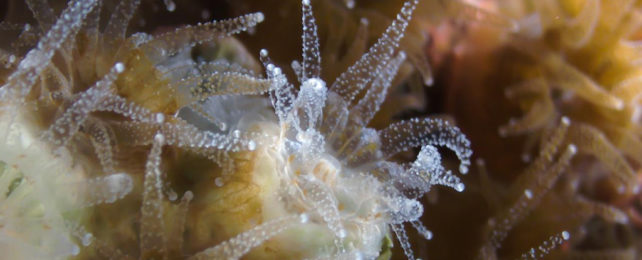Like so many animals, the northern star coral (Astrangia poculata) spends its winter in a state of hibernation.
Don't let the downtime fool you, though. There's a lot of house cleaning going on around those resting polyps.
According to a new study led by a researchers from the University of California, Davis, the microbial communities that live on the coral are shuffled about during its annual rest break, preparing it for the next season.
The discovery could give us a better idea of how corals might respond to climate change. As our ocean's waters warm, protecting the microbiome of corals is going to be essential – and these findings could provide experts with valuable information on how best to keep the corals in a healthy state.
"Dormancy, at its most basic, is a response to an environmental stressor – in this case, cold stress," says University of California, Davis, community ecologist Anya Brown, previously a researcher with the Woods Hole Oceanographic Institution.
"If we understand more about this recovery period, it might help us understand what microbes may be responsible for recovering coral in warmer tropical systems."
The norther star coral lives in the Atlantic Ocean, its range extending from the Gulf of Mexico to Massachusetts. When the water temperature drops, the coral goes into a deep sleep: it retracts its tentacles, stops eating, and ignores physical touch.
Between October 2020 and May 2021, Brown and her colleagues collected 10 distinct colonies of the A. poculata coral from depths of 60 feet (around 18 meters) off the coast of Massachusetts. These were split into three categories representing specimens taken before, during, and after hibernation.
Gene sequencing analysis of the specimens' microbiomes revealed that during periods of dormancy, microbes associated with pathogens are released, as are microbes that absorb nutrients.
Microbes that can supply nitrogen to the coral, on the other hand, increase in number, suggesting the coral effectively streamlines its microbial community while retaining some diversity.
That matches the team's hypothesis – that there's a "reset and restructure" process going on, which protects the microbial community and meets the coral's needs while it is both 'awake' and 'asleep'.
"This study shows that microbes respond to stress and recover in a predictable pattern," says marine microbial ecologist Amy Apprill, from the Woods Hole Oceanographic Institution in Massachusetts. "It's foundational knowledge that may help us develop probiotics or other microbial treatments for stressed tropical corals."
It's the first time that a persistent microbial community shift has been recorded in a marine animal during a period of dormancy, although it has been noticed in other wildlife: there's a shift in the microbiome of ground squirrels, for example, that increases nitrogen recycling rates during hibernation.
The next step is to more clearly identify the microbes that help the coral stay protected and recover from disturbances. Further down the line, they could be harnessed or engineered to maintain coral health.
Further investigation is required to establish whether the coral is actively ejecting and recruiting certain microbes or whether they're leaving and arriving more of their own accord – samplings over a greater time period and a wider area should reveal more.
"This work opens a lot of questions," says Brown. "A big one is: why does the coral wake up in the early spring? This study suggests that key microbial groups may play an important role in triggering the onset of or emergence from this coral's dormancy and the regulation of its microbiome."
The research has been published in Applied and Environmental Microbiology.
